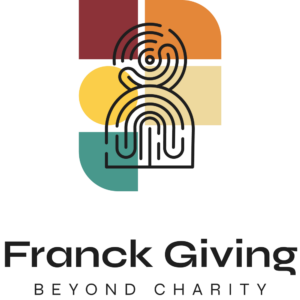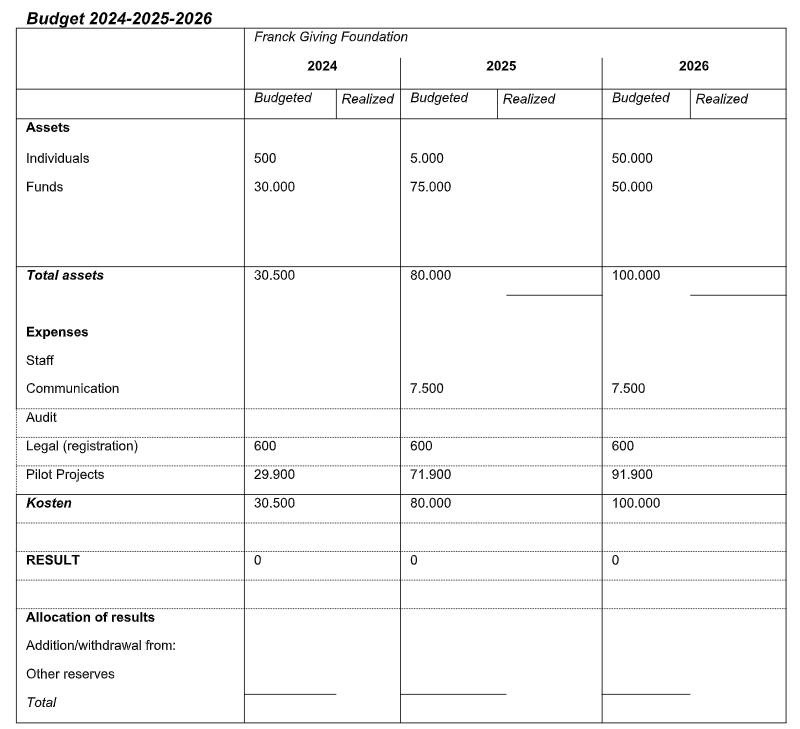POLICY PLAN 2024 – 2026
Franck Giving Foundation
Chamber of Commerce: 95003185
Reference: policy-plan-2024-2026
Date: September 25, 2024
Status: Final
Author(s): Dirkje Jansen
Approval: Board Meeting, October 1, 2024
I. Introduction
In 2024, the Franck Giving Foundation was established. This policy plan pertains to the period 2024 – 2026. In this policy plan, the board outlines the objectives and expected results of the collective effort during the mentioned period.
II.Vision and Mission
A. Vision
The board of the Franck Giving Foundation recognizes that the world’s poorest group of people is often not effectively reached by organizations and projects serving their interests. Insufficient progress is being made in improving the living conditions of this group. Furthermore, these individuals have limited influence over and insight into the choices made to improve their living conditions.
The Franck Giving Foundation believes that the use of donation funds worldwide should be more transparent, verifiable, and impactful. This is crucial so that a larger portion of the donations actually reaches the people who need it most.
The Franck Giving Foundation has prioritized the following policy areas based on their impact on overall well-being — and as essential conditions for development: education, agriculture, water & sanitation, livelihood, and energy.
B. Mission
The goal of the Franck Giving Foundation is to make donations directly, effectively, impactfully, and traceably available in areas of Africa where the most vulnerable families live.
III. Ambitions
In the current policy period, the Franck Giving Foundation aims to enable direct donations between donors and service providers (within the selected policy areas in Africa), and to make the impact of the donations measurable, traceable, and verifiable. The foundation intends to achieve this by leveraging existing technologies.
The Franck Giving Foundation has determined its country strategy based on thorough research into: technological acceptance, social development indicators, economic wealth in a country, and the ease of operating in a country.
A. Projects
The next steps will be further determined based on a few pilot projects. Since the Franck Giving Foundation is attempting to develop something new, it will have a very high learning capacity. This policy plan outlines the framework.
Each pilot project will be assessed and approved by the board based on the following criteria:
– Alignment with the foundation’s policy plan
– Available financial resources
B. Accountability
Annually, the income and expenses are accounted for in our financial annual report. Once a website is available, these reports will be published on our website.
For each specific project, a separate report (both content and financial) will be prepared, tailored to the requirements of the financiers.
C. Fundraising
To obtain the necessary funds, we focus on the following groups:
– Funds
– Companies
– Foundations
– Private donors
To achieve this, the Franck Giving Foundation will build targeted relationships and, with a future-oriented approach, recruit and inform its network and donors via the (own) website and social media platforms such as LinkedIn and Instagram.
IV. Opportunities & Threats
A. Opportunities
Complex social challenges, such as the decline in development budgets and the increased mistrust between donors and recipients, create an opportunity for an innovative and more transparent approach.
The strength of our foundation in achieving our goal lies in the composition of the team, which has extensive experience in relevant sectors. In addition, the Franck Giving Foundation is seeking a strategic partnership with a technical company that has expertise in making steps in a process traceable and verifiable.
B. Threats
In the next three years, we will need to find a solution for the registration requirements in various countries concerning public organizations. Ultimately, the goal is to make donations possible from countries with an emerging middle class—and make them tax-deductible—but national registration requirements could hinder scalability.
Existing technologies are always evolving. Utilizing such technologies can be a challenge in certain vulnerable and hard-to-access areas.
Corruption is always a lurking risk. As a foundation, we also face the risk of encountering corruption. In addition to implementing preventive measures—such as clearly communicating the requirements we set for our partners—we are looking for ways to quickly detect and address corruption.
The current system involves significant dependency and vulnerability—of the people for whom the resources are intended, in relation to the organizations and governments that distribute the resources. This undesirable situation not only results in fewer resources reaching the target group than necessary, but it also contributes to limited autonomy. It is a challenge for Franck Giving to seek a balance between control and independence in its model.
V. Strategic Action Plan
Fundraising
1. Establishing suitable social media channels and branding
2. Building and maintaining a network of financiers and donors
Project Progress and Accountability
3. Inspiring and content-rich reports that build trust in the mission of the Franck Giving Foundation
4. The branding and naming of the foundation and its method will be further developed throughout 2025
Governance
5. The board will determine the composition of the board for the future.
6. The board will outline tasks, roles, conflict resolution, and conflict of interest in a memorandum.
7. The annual report will be published every year before July 1st on media channels.
8. In accordance with the GDPR, a privacy protocol will be developed starting in 2025, so that we comply with legal regulations by 2026.
The board consists of four members. The board will meet at least 4 times a year, and is responsible for financial reporting and steering the policy plan at a high level.
Board members serve without remuneration.
Core Values
The core values of our foundation are:
– Compassion
– Transparency
– Equity
VI. Budget
Annex I: Argumentation
I. People are more likely to donate when they know where their money is going and how it is being used. Research shows that up to 90% of people are more inclined to donate if there is transparency regarding the allocation of their funds.
II. A large portion of donations never reaches the intended recipient country. Instead, it stays in the donor country (for purposes such as debt relief, scholarships for students, administrative overhead, and refugee support). It is also used to purchase goods and services from third countries. Throughout the entire chain of ‘development cooperation and aid,’ organizations that receive money may use a portion of it to cover their own administrative costs, and in the case of international NGOs and consultancy firms, this can mean that a significant portion of the funds never reaches the ‘assisted’ country.
III. The number of poor people in Africa is increasing.



